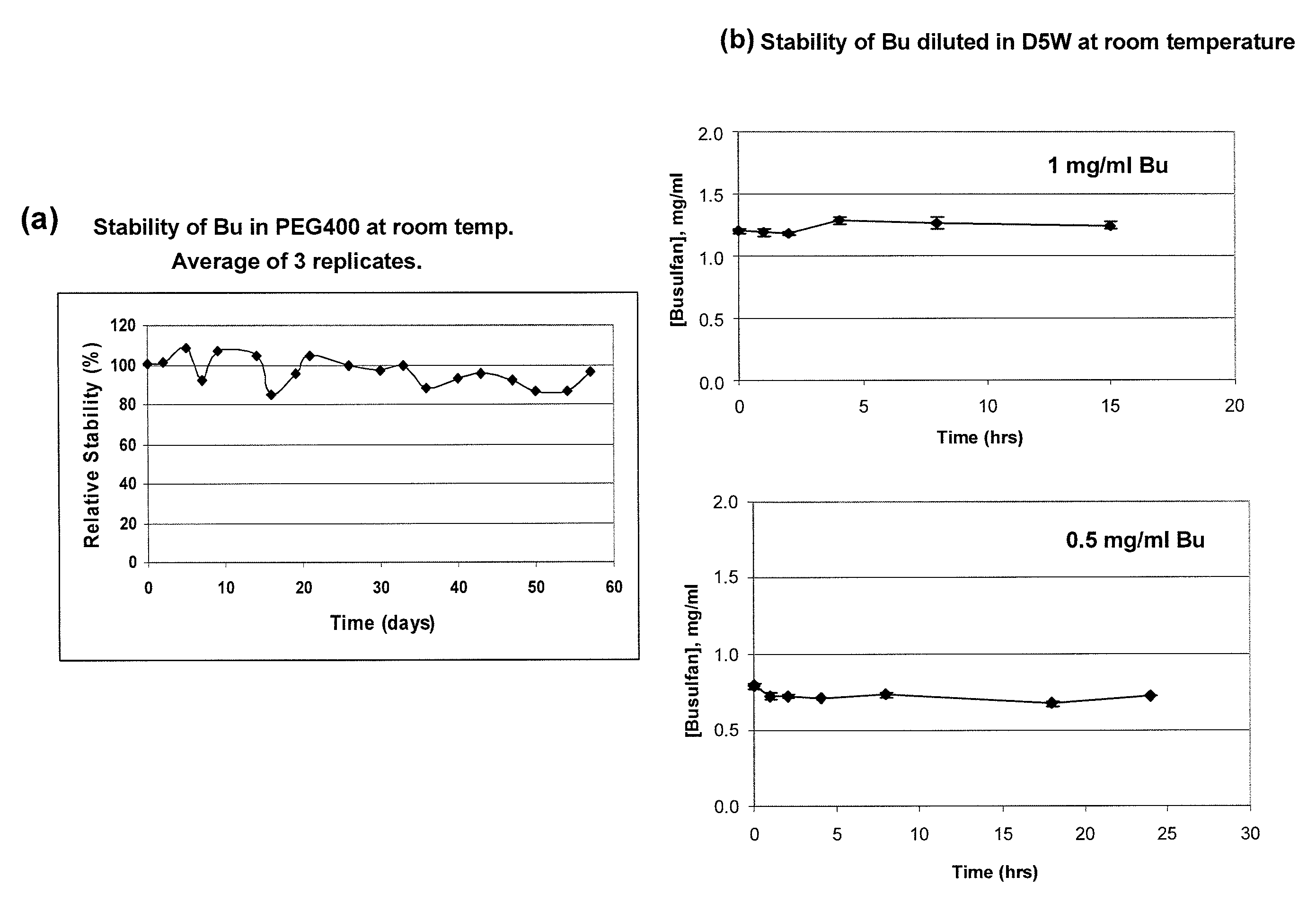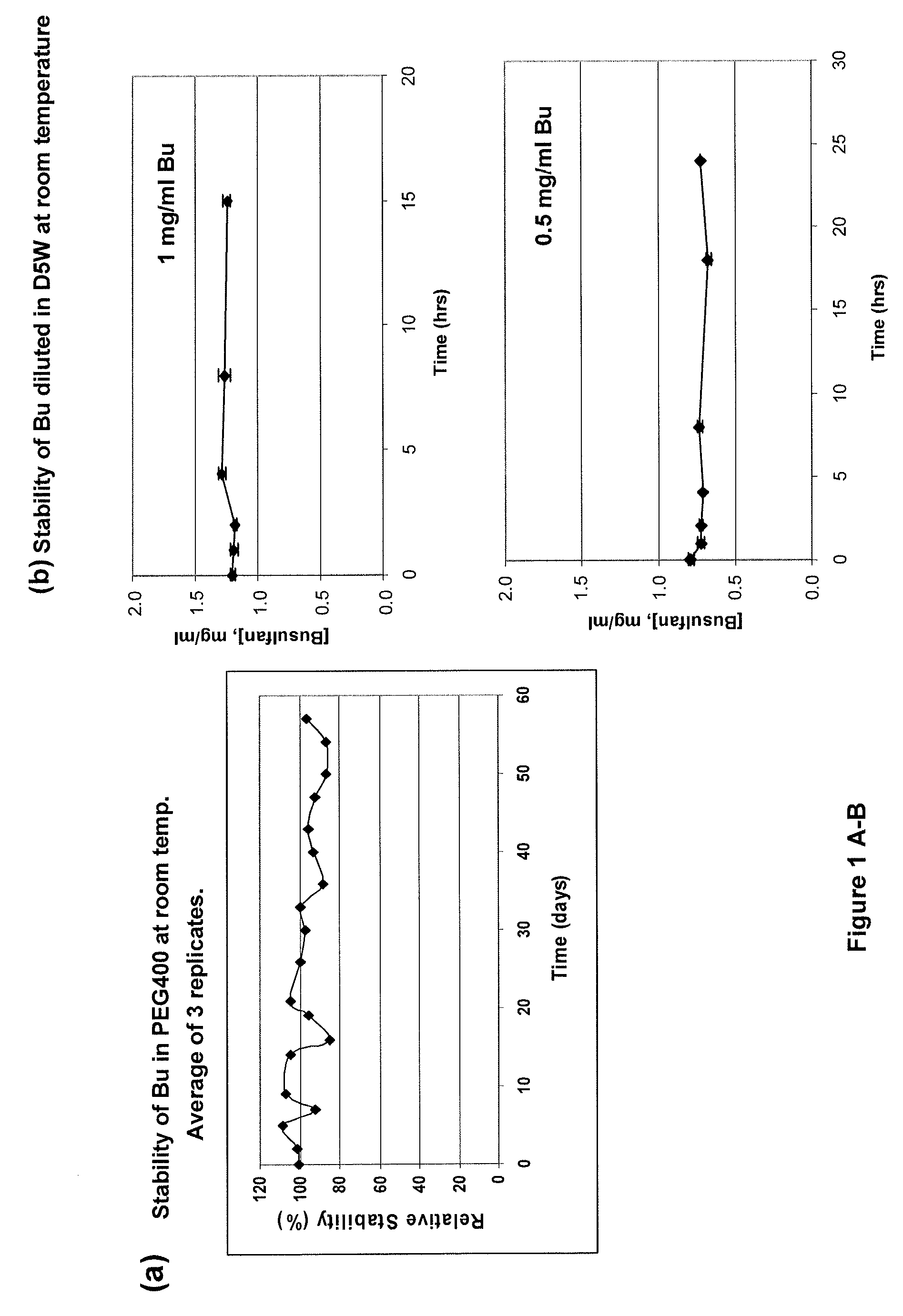Parenteral formulations of lipophilic pharmaceutical agents and methods for preparing and using the same
a technology of lipophilic pharmaceutical agents and formulations, which is applied in the field of parenteral formulations of lipophilic pharmaceutical agents and methods for preparing and using the same, can solve the problems of poor fat solubility, major obstacles to the development of therapeutic agents, and parenteral dosage forms, so as to facilitate the solubilization of lipophilic agents and improve solubility and stability
- Summary
- Abstract
- Description
- Claims
- Application Information
AI Technical Summary
Benefits of technology
Problems solved by technology
Method used
Image
Examples
example 1
Busulfan and Azole Parenteral Formulations
[0168]This example demonstrates the successful design of stable formulations of busulfan (Bu), using solvent vehicles that are nontoxic and suitable for parenteral administration. The necessary solubility / stability was calculated, and preparations were evaluated with high-pressure liquid chromatographic (HPLC) technique. The desired solubility and stability of Bu in various solvents relevant for parenteral, (as represented by intravascular or intrathecal or intracavitary) administration in humans and domestic animals was defined, and the solubility of Bu in physiologically acceptable vehicles was determined.
[0169]Preparation of Prototype Solvent Vehicle and Primary Stock Solution.
[0170]A preferred Bu Vacuum-Extracted or Vacuum-Evaporated acetone (VE-acetone) / PEG / Bu (“primary stock solution”) as referenced in these Examples was prepared as follows: 10 mg / mL of Bu was solubilized in acetone, mixed with PEG400 (1:2, v / v), then extracted at RT u...
example 2
Demonstration of In vitro Solubility, Stability and Other Properties of One of the Novel Formulations
[0207]In this example, stable Bu- and azole-(Posaconazole; Posa) formulations that would be suitable for human administration were evaluated. The chemical and physical stability of Bu and Posa in (a) composite solvent vehicle(s) were established. Further, the solubility of Bu and Posa in these composite solvent vehicles was established, using NS or D5W±20% PEG as the final diluent. This example also investigated the in vitro cytotoxic and antifungal properties of the respective formulations, including their hemolytic potential, cytotoxic / antifungal activity against human malignant cell lines and mold isolates, to establish that the solvent system is appropriate for parenteral administration as therapy for malignant or autoimmune diseases as well as against fungal / mold infections in humans and other mammals without loss of the therapeutic properties of the respective class of agents.
[...
example 3
Quantitative Busulfan Analysis in Plasma and Pharmacology of IV Bu
[0242]This example demonstrates that Bu and azole antifungal antibiotics in (a) preferred solvent vehicle(s) and mixed with blood plasma may be recovered as native / intact drug using quantitative extraction technology and HPLC assay, and that the drugs remain stable in a cytotoxic / fungistatic concentration range for several hours after administration. It further shows that the preliminary plasma pharmacokinetics after parenteral administration of a preferred Bu formulation in mice conforms to what can be expected, based on the published pharmacology of oral and IV Bu (Slattery et al., 1997; Dix et al., 1996; Hassan et al., 2000; Hassan et al., 1989; Bhagwatwar et al., 1996; Andersson et al., 2000; Andersson et al., 2002; Russell et al., 2002; De Lima et al., 2004; Madden et al., 2007; Busulfex, 2009).
[0243]Quantitative Extraction of Busulfan in Plasma
[0244]One mL of human plasma was mixed with various amounts of the re...
PUM
| Property | Measurement | Unit |
|---|---|---|
| concentration | aaaaa | aaaaa |
| concentration | aaaaa | aaaaa |
| concentration | aaaaa | aaaaa |
Abstract
Description
Claims
Application Information
 Login to View More
Login to View More - R&D
- Intellectual Property
- Life Sciences
- Materials
- Tech Scout
- Unparalleled Data Quality
- Higher Quality Content
- 60% Fewer Hallucinations
Browse by: Latest US Patents, China's latest patents, Technical Efficacy Thesaurus, Application Domain, Technology Topic, Popular Technical Reports.
© 2025 PatSnap. All rights reserved.Legal|Privacy policy|Modern Slavery Act Transparency Statement|Sitemap|About US| Contact US: help@patsnap.com



